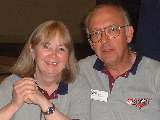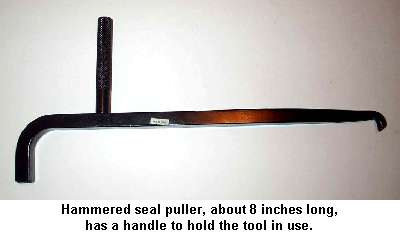 Just a Simple Wrench
Just a Simple Wrench
by Ann & Jake Snyder
Braking Down
The brakes on the '73 GT felt strange while the car was still in the driveway. A check on the brake fluid level showed the rear reservoir on the non-power assisted dual system was empty. The '73 GT went into the garage and stayed there for several days and the '74 1/2 GT got exercised instead, until the day before the camping trip to Road America. Then the '73 GT had to be repaired because it has an overdrive gearbox that works most of the time. (There is a pattern in how we defer repair work of all kinds, but we do have a rebuilt overdrive gearbox ready to install in the '74 1/2 GT). And the several days the '73 GT was sitting unattended made both of us nervous because having an brake system open to moisture by having it drained out can lead to rust and other failures in the system.
It was late in the afternoon when an essential oil change and greasing were finished - these maintenance chores are never deferred. The GT with the bad back brakes was jacked up under the differential and set on jack stands. That way both sides could be repaired at the same time, though the work space in our crowded garage approaches the absolute minimum when both sides must be worked on without moving the car over a few feet one way or the other.
The left rear tire had a clear trail of something down the side wall, so we started there. Loosening the adjuster, kept rust-free with an inch of fuel line packed with red grease over the screw, was easy and the cross-headed screws that ornament the brake drum quickly yielded to the hand impact screwdriver. Pulling off the brake drum revealed a most disgusting mess, far too much and too dirty to be just brake fluid. The axle seal had also failed. The brake hardware was removed, and all the springs were still useable. The brake shoes went in the trash, followed shortly by the wheel cylinder. The brake fitting was heated to eliminate twisting the brake line in the event the two had formed a rusty association. We have a special cold chisel that is ground blunt, and the E-clip came off without flying into our eyes or some dark corner of the garage. We jammed a tire iron between the axle studs and the floor, holding the axle well enough to remove the hub nut after heating it with enthusiasm and a MAPP torch. The metal sealing collar that gives a machined surface for the rubber seal was removed, inspected and determined to be good. Now came the first of our simple tools, one we could have made ourselves, but that we had purchased on an impulse from one of those mailers that comes around all the time. A few taps, and the rubber seal was out. While there are a dozen ways to remove a seal, the hammered seal puller actually worked well. Reassembly was the reverse.

Well, not quite, because fitting a wheel cylinder to the backplate is never easy. We usually make certain we have at least 6 E-clips on hand, due to their habit of flying off, never to be found until they are too rusty to use. But, we had purchased, on an impulse from one of those MG mailers that comes around all the time, a clever little E-clip installer. Considering that E-clips cost a dollar each, and that a lot get lost using the blunt chisel-and-hammer method, it seemed like a good investment. And it worked reasonably efficiently and quickly.


Unfortunately, bad brake cylinders come in pairs, and we could not consider the job finished until the other side was done, as well. And, we found a small leak from the oil seal, though the leak had just started. As a consequence, we got to use the hammered seal puller as well as the E-clip installation tool twice in one night.
The arrow shows where the backing plate would be after the wheel cylinder is fitted to it. The tool screws into the brake line hole, and the nut on the end forces the hollow anvil on to the cone on which the E-clip is placed. After the E-clip is forced to the end of the cone, it can be slipped over the end of the wheel cylinder and into the groove.
|
It was late now, and everything was taking longer. We filled the system, bled the brakes using a 9/32 ignition wrench, adjusted them, and verified that the drums did not turn with the brakes applied. The road wheels were refitted, the car let down from the jack stands and the lug nuts torqued with the big cross wrench. Later that morning, when the sun had come up, the master cylinder was still full, and the wheels could be locked on the gravel driveway when the brakes were hit hard. We were ready to go.
Well, not quite. The brakes still felt strange on the Interstate, and we tripled our interval, giving everyone else an easy place to pull into our lane in front of us. We spent the extra driving time wondering if the rear section of the master cylinder had bad seals. At the very least, we told each other, we would bleed the brakes again. Too bad the 9/32 wrench was in the garage, so we stopped at the big farm supply store about five miles south of the track. They had a 9/32 socket, which would not work, but which was very close in size to a 7mm wrench that cost $1.49. And we always have a bottle of Castrol LMA brake fluid, so, after we had set up our tent, we pulled out our final simple tool, and this one had cost nothing at all. It is our piece of cardboard, two feet wide and about 6 feet long, that we fold in thirds and store beneath the GT's back mat, along with the spare road atlas and spare water pump gasket.
The piece of cardboard, though of no commercial value, has much sentimental value for us. It provided a minimum of comfort while lying in the rain feeling for clutch action, and it was our catch-all for falling headpipe nuts that had to be replaced on one of the thousand-mile rallies after we found a ditch to straddle the car to make access possible. Every stain on that piece of cardboard is important to us. And to these pleasant memories we would now add bleeding the brake system.
The actual job was over in an instant. "Ready" from the driver, twist the bleed screw and "Down" from the mechanic, followed by a little pop of air. Once or twice more, and it was off to the festivities with brakes that functioned well. .... After folding and stowing the cardboard, of course.
|





